Regulatory Compliance with DevOps Toolchains in IT Organizations
VerifiedAdded on 2023/03/30
|10
|1828
|173
Report
AI Summary
This report provides an overview and analysis of DevOps toolchains and their associated regulations, emphasizing the importance of compliance in IT organizations. It discusses how DevOps can improve collaboration and communication but also introduces complexities in IT infrastructure that can hinder compliance efforts. The report highlights key findings, including the potential of DevOps to transform service delivery, the role of infrastructure management tools in simplifying IT operations, and the importance of automation and visibility in achieving compliance. Recommendations are provided for improving control activities, leveraging peer review methodologies, and monitoring compliance with system standards to mitigate risks and ensure business success. License tracking is identified as a crucial technique for maintaining compliance with software usage standards and guidelines in a DevOps environment. Desklib offers a platform to explore similar solved assignments and study resources for students.
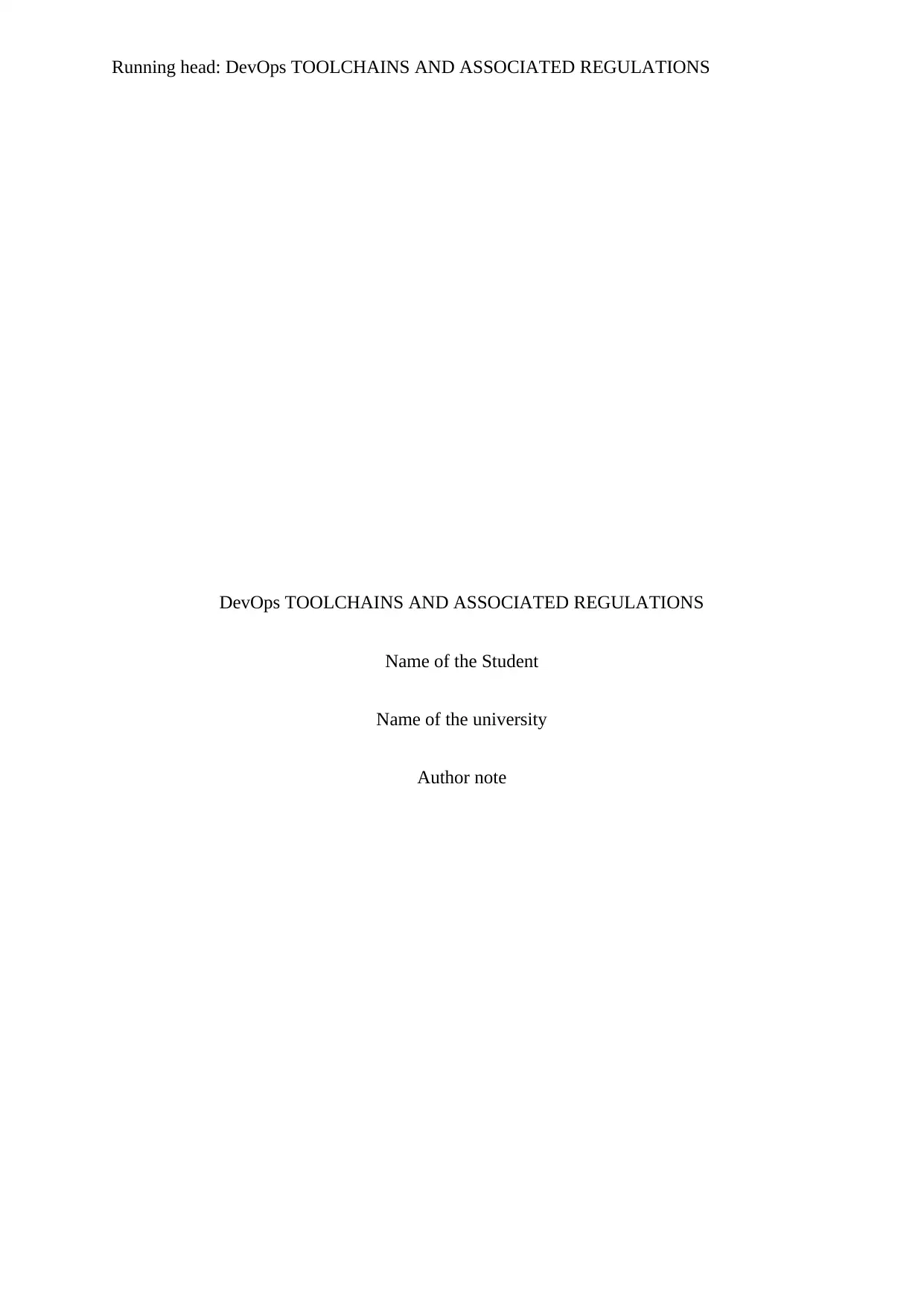
Running head: DevOps TOOLCHAINS AND ASSOCIATED REGULATIONS
DevOps TOOLCHAINS AND ASSOCIATED REGULATIONS
Name of the Student
Name of the university
Author note
DevOps TOOLCHAINS AND ASSOCIATED REGULATIONS
Name of the Student
Name of the university
Author note
Paraphrase This Document
Need a fresh take? Get an instant paraphrase of this document with our AI Paraphraser
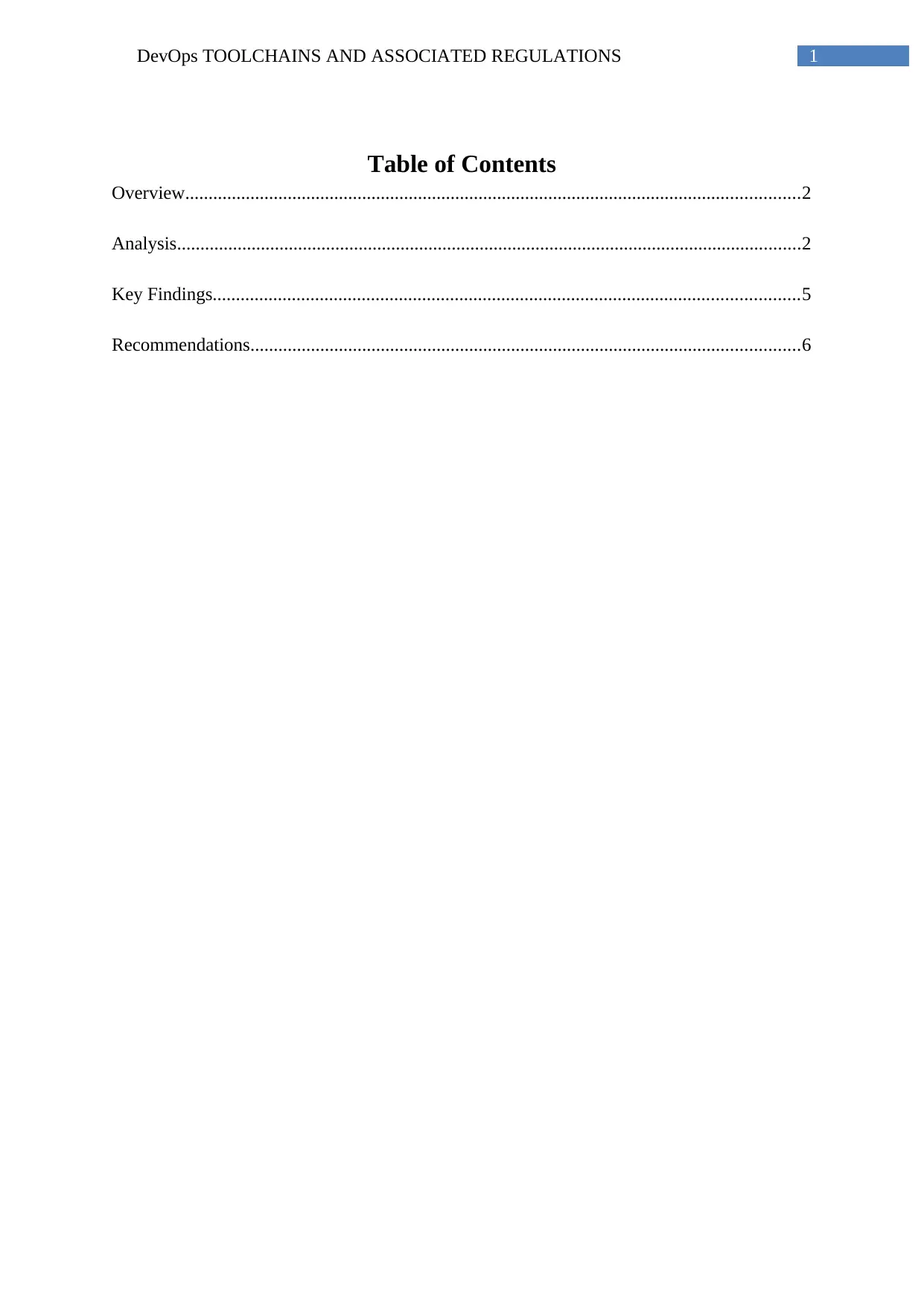
1DevOps TOOLCHAINS AND ASSOCIATED REGULATIONS
Table of Contents
Overview....................................................................................................................................2
Analysis......................................................................................................................................2
Key Findings..............................................................................................................................5
Recommendations......................................................................................................................6
Table of Contents
Overview....................................................................................................................................2
Analysis......................................................................................................................................2
Key Findings..............................................................................................................................5
Recommendations......................................................................................................................6
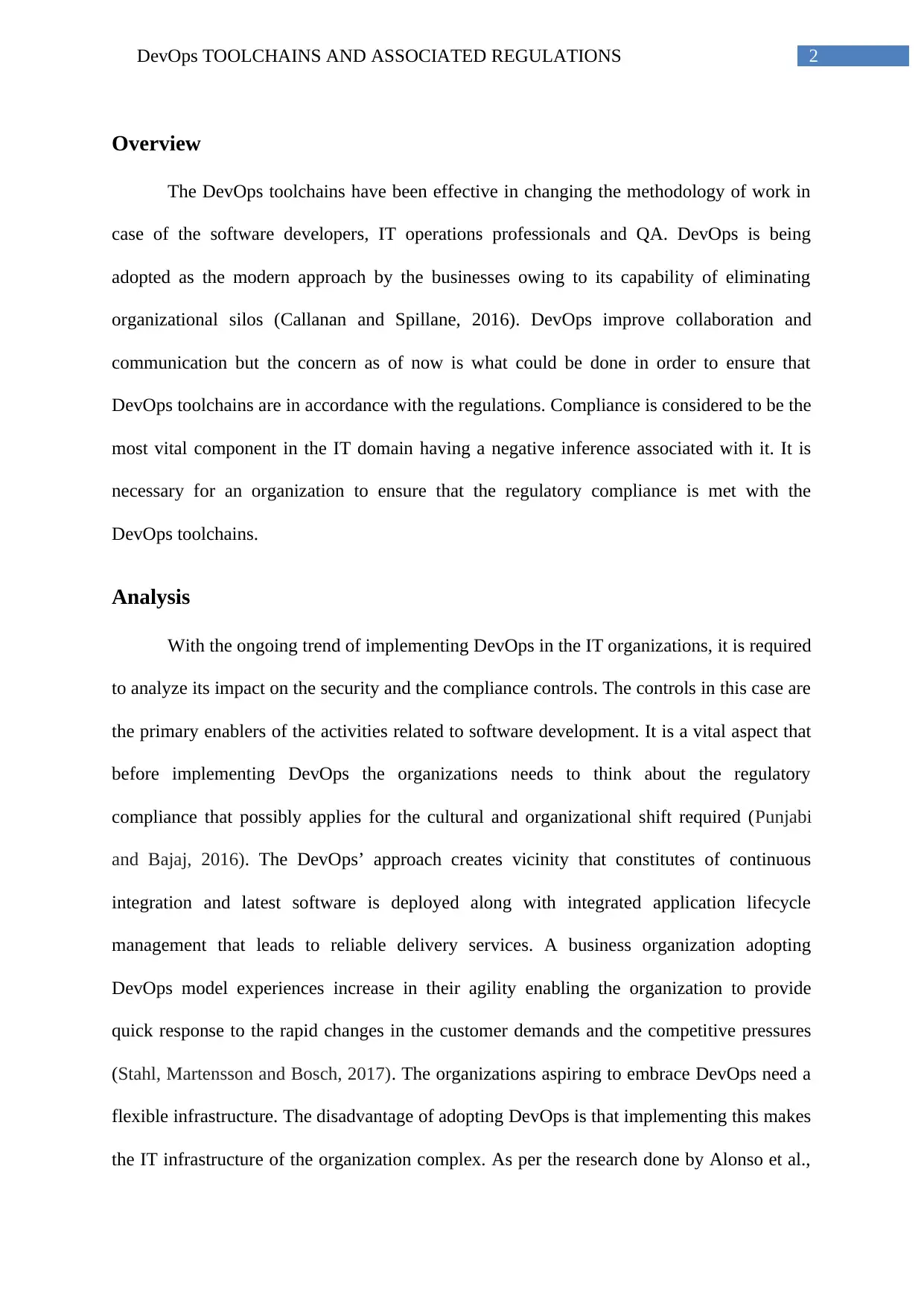
2DevOps TOOLCHAINS AND ASSOCIATED REGULATIONS
Overview
The DevOps toolchains have been effective in changing the methodology of work in
case of the software developers, IT operations professionals and QA. DevOps is being
adopted as the modern approach by the businesses owing to its capability of eliminating
organizational silos (Callanan and Spillane, 2016). DevOps improve collaboration and
communication but the concern as of now is what could be done in order to ensure that
DevOps toolchains are in accordance with the regulations. Compliance is considered to be the
most vital component in the IT domain having a negative inference associated with it. It is
necessary for an organization to ensure that the regulatory compliance is met with the
DevOps toolchains.
Analysis
With the ongoing trend of implementing DevOps in the IT organizations, it is required
to analyze its impact on the security and the compliance controls. The controls in this case are
the primary enablers of the activities related to software development. It is a vital aspect that
before implementing DevOps the organizations needs to think about the regulatory
compliance that possibly applies for the cultural and organizational shift required (Punjabi
and Bajaj, 2016). The DevOps’ approach creates vicinity that constitutes of continuous
integration and latest software is deployed along with integrated application lifecycle
management that leads to reliable delivery services. A business organization adopting
DevOps model experiences increase in their agility enabling the organization to provide
quick response to the rapid changes in the customer demands and the competitive pressures
(Stahl, Martensson and Bosch, 2017). The organizations aspiring to embrace DevOps need a
flexible infrastructure. The disadvantage of adopting DevOps is that implementing this makes
the IT infrastructure of the organization complex. As per the research done by Alonso et al.,
Overview
The DevOps toolchains have been effective in changing the methodology of work in
case of the software developers, IT operations professionals and QA. DevOps is being
adopted as the modern approach by the businesses owing to its capability of eliminating
organizational silos (Callanan and Spillane, 2016). DevOps improve collaboration and
communication but the concern as of now is what could be done in order to ensure that
DevOps toolchains are in accordance with the regulations. Compliance is considered to be the
most vital component in the IT domain having a negative inference associated with it. It is
necessary for an organization to ensure that the regulatory compliance is met with the
DevOps toolchains.
Analysis
With the ongoing trend of implementing DevOps in the IT organizations, it is required
to analyze its impact on the security and the compliance controls. The controls in this case are
the primary enablers of the activities related to software development. It is a vital aspect that
before implementing DevOps the organizations needs to think about the regulatory
compliance that possibly applies for the cultural and organizational shift required (Punjabi
and Bajaj, 2016). The DevOps’ approach creates vicinity that constitutes of continuous
integration and latest software is deployed along with integrated application lifecycle
management that leads to reliable delivery services. A business organization adopting
DevOps model experiences increase in their agility enabling the organization to provide
quick response to the rapid changes in the customer demands and the competitive pressures
(Stahl, Martensson and Bosch, 2017). The organizations aspiring to embrace DevOps need a
flexible infrastructure. The disadvantage of adopting DevOps is that implementing this makes
the IT infrastructure of the organization complex. As per the research done by Alonso et al.,
⊘ This is a preview!⊘
Do you want full access?
Subscribe today to unlock all pages.

Trusted by 1+ million students worldwide
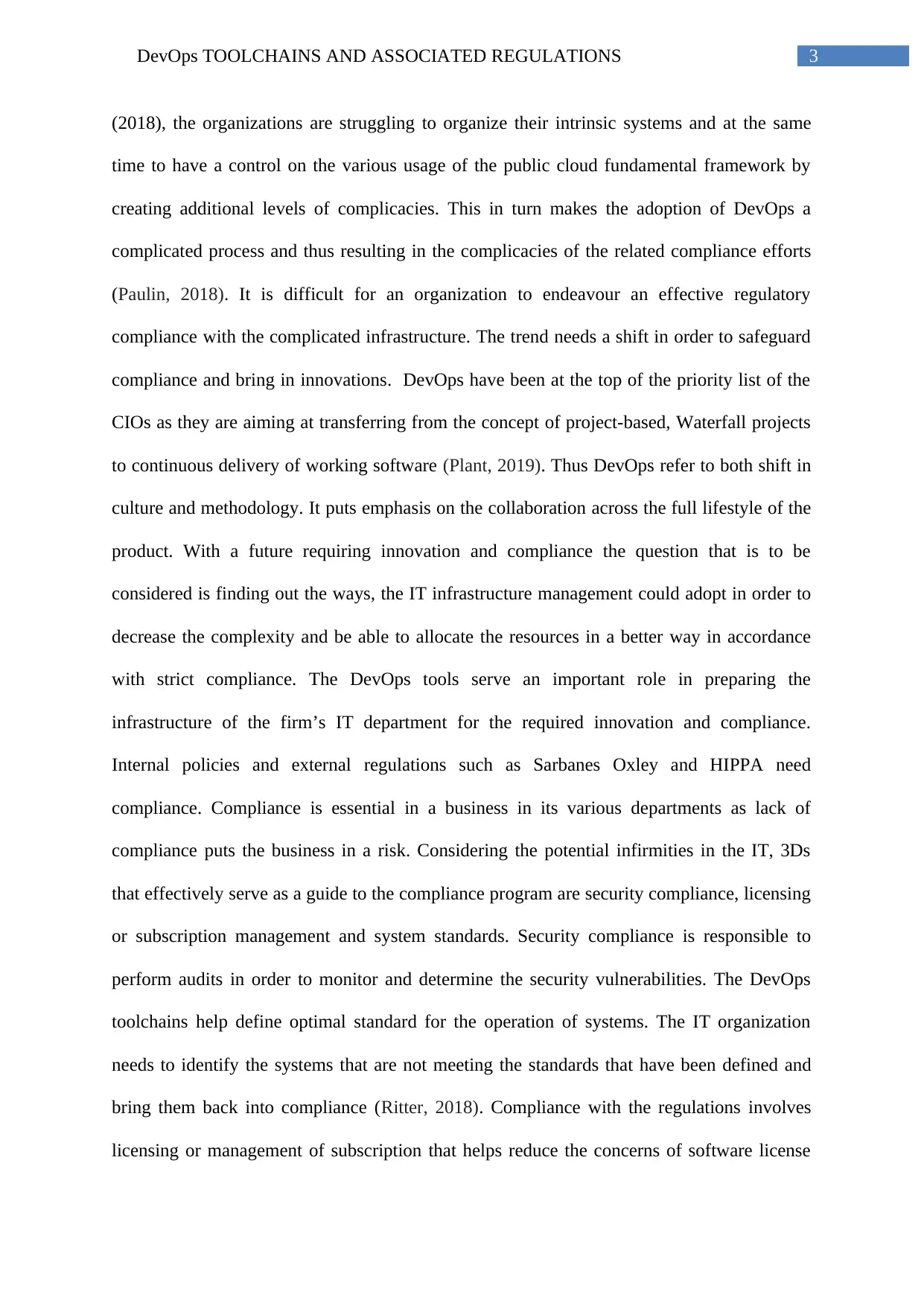
3DevOps TOOLCHAINS AND ASSOCIATED REGULATIONS
(2018), the organizations are struggling to organize their intrinsic systems and at the same
time to have a control on the various usage of the public cloud fundamental framework by
creating additional levels of complicacies. This in turn makes the adoption of DevOps a
complicated process and thus resulting in the complicacies of the related compliance efforts
(Paulin, 2018). It is difficult for an organization to endeavour an effective regulatory
compliance with the complicated infrastructure. The trend needs a shift in order to safeguard
compliance and bring in innovations. DevOps have been at the top of the priority list of the
CIOs as they are aiming at transferring from the concept of project-based, Waterfall projects
to continuous delivery of working software (Plant, 2019). Thus DevOps refer to both shift in
culture and methodology. It puts emphasis on the collaboration across the full lifestyle of the
product. With a future requiring innovation and compliance the question that is to be
considered is finding out the ways, the IT infrastructure management could adopt in order to
decrease the complexity and be able to allocate the resources in a better way in accordance
with strict compliance. The DevOps tools serve an important role in preparing the
infrastructure of the firm’s IT department for the required innovation and compliance.
Internal policies and external regulations such as Sarbanes Oxley and HIPPA need
compliance. Compliance is essential in a business in its various departments as lack of
compliance puts the business in a risk. Considering the potential infirmities in the IT, 3Ds
that effectively serve as a guide to the compliance program are security compliance, licensing
or subscription management and system standards. Security compliance is responsible to
perform audits in order to monitor and determine the security vulnerabilities. The DevOps
toolchains help define optimal standard for the operation of systems. The IT organization
needs to identify the systems that are not meeting the standards that have been defined and
bring them back into compliance (Ritter, 2018). Compliance with the regulations involves
licensing or management of subscription that helps reduce the concerns of software license
(2018), the organizations are struggling to organize their intrinsic systems and at the same
time to have a control on the various usage of the public cloud fundamental framework by
creating additional levels of complicacies. This in turn makes the adoption of DevOps a
complicated process and thus resulting in the complicacies of the related compliance efforts
(Paulin, 2018). It is difficult for an organization to endeavour an effective regulatory
compliance with the complicated infrastructure. The trend needs a shift in order to safeguard
compliance and bring in innovations. DevOps have been at the top of the priority list of the
CIOs as they are aiming at transferring from the concept of project-based, Waterfall projects
to continuous delivery of working software (Plant, 2019). Thus DevOps refer to both shift in
culture and methodology. It puts emphasis on the collaboration across the full lifestyle of the
product. With a future requiring innovation and compliance the question that is to be
considered is finding out the ways, the IT infrastructure management could adopt in order to
decrease the complexity and be able to allocate the resources in a better way in accordance
with strict compliance. The DevOps tools serve an important role in preparing the
infrastructure of the firm’s IT department for the required innovation and compliance.
Internal policies and external regulations such as Sarbanes Oxley and HIPPA need
compliance. Compliance is essential in a business in its various departments as lack of
compliance puts the business in a risk. Considering the potential infirmities in the IT, 3Ds
that effectively serve as a guide to the compliance program are security compliance, licensing
or subscription management and system standards. Security compliance is responsible to
perform audits in order to monitor and determine the security vulnerabilities. The DevOps
toolchains help define optimal standard for the operation of systems. The IT organization
needs to identify the systems that are not meeting the standards that have been defined and
bring them back into compliance (Ritter, 2018). Compliance with the regulations involves
licensing or management of subscription that helps reduce the concerns of software license
Paraphrase This Document
Need a fresh take? Get an instant paraphrase of this document with our AI Paraphraser
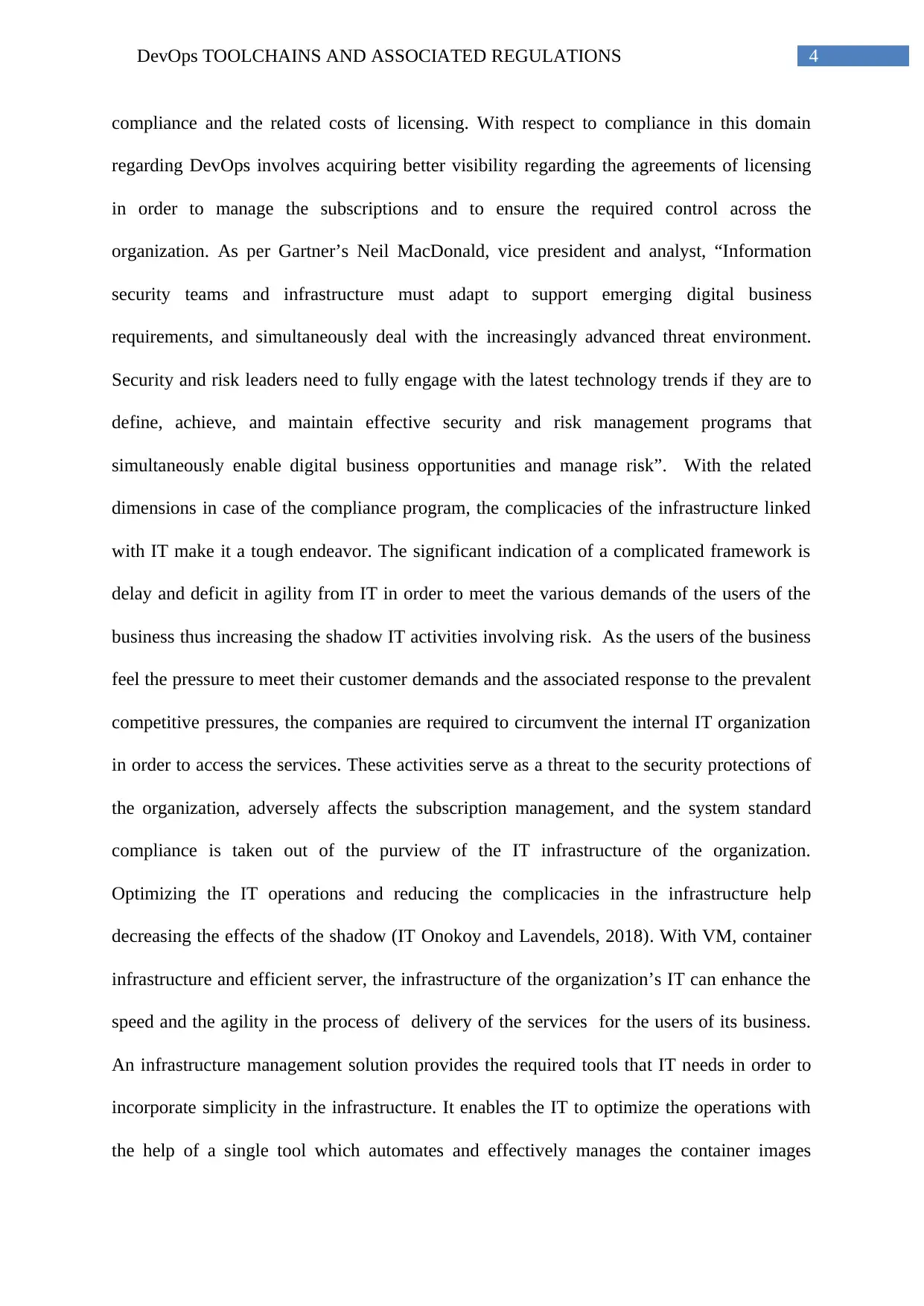
4DevOps TOOLCHAINS AND ASSOCIATED REGULATIONS
compliance and the related costs of licensing. With respect to compliance in this domain
regarding DevOps involves acquiring better visibility regarding the agreements of licensing
in order to manage the subscriptions and to ensure the required control across the
organization. As per Gartner’s Neil MacDonald, vice president and analyst, “Information
security teams and infrastructure must adapt to support emerging digital business
requirements, and simultaneously deal with the increasingly advanced threat environment.
Security and risk leaders need to fully engage with the latest technology trends if they are to
define, achieve, and maintain effective security and risk management programs that
simultaneously enable digital business opportunities and manage risk”. With the related
dimensions in case of the compliance program, the complicacies of the infrastructure linked
with IT make it a tough endeavor. The significant indication of a complicated framework is
delay and deficit in agility from IT in order to meet the various demands of the users of the
business thus increasing the shadow IT activities involving risk. As the users of the business
feel the pressure to meet their customer demands and the associated response to the prevalent
competitive pressures, the companies are required to circumvent the internal IT organization
in order to access the services. These activities serve as a threat to the security protections of
the organization, adversely affects the subscription management, and the system standard
compliance is taken out of the purview of the IT infrastructure of the organization.
Optimizing the IT operations and reducing the complicacies in the infrastructure help
decreasing the effects of the shadow (IT Onokoy and Lavendels, 2018). With VM, container
infrastructure and efficient server, the infrastructure of the organization’s IT can enhance the
speed and the agility in the process of delivery of the services for the users of its business.
An infrastructure management solution provides the required tools that IT needs in order to
incorporate simplicity in the infrastructure. It enables the IT to optimize the operations with
the help of a single tool which automates and effectively manages the container images
compliance and the related costs of licensing. With respect to compliance in this domain
regarding DevOps involves acquiring better visibility regarding the agreements of licensing
in order to manage the subscriptions and to ensure the required control across the
organization. As per Gartner’s Neil MacDonald, vice president and analyst, “Information
security teams and infrastructure must adapt to support emerging digital business
requirements, and simultaneously deal with the increasingly advanced threat environment.
Security and risk leaders need to fully engage with the latest technology trends if they are to
define, achieve, and maintain effective security and risk management programs that
simultaneously enable digital business opportunities and manage risk”. With the related
dimensions in case of the compliance program, the complicacies of the infrastructure linked
with IT make it a tough endeavor. The significant indication of a complicated framework is
delay and deficit in agility from IT in order to meet the various demands of the users of the
business thus increasing the shadow IT activities involving risk. As the users of the business
feel the pressure to meet their customer demands and the associated response to the prevalent
competitive pressures, the companies are required to circumvent the internal IT organization
in order to access the services. These activities serve as a threat to the security protections of
the organization, adversely affects the subscription management, and the system standard
compliance is taken out of the purview of the IT infrastructure of the organization.
Optimizing the IT operations and reducing the complicacies in the infrastructure help
decreasing the effects of the shadow (IT Onokoy and Lavendels, 2018). With VM, container
infrastructure and efficient server, the infrastructure of the organization’s IT can enhance the
speed and the agility in the process of delivery of the services for the users of its business.
An infrastructure management solution provides the required tools that IT needs in order to
incorporate simplicity in the infrastructure. It enables the IT to optimize the operations with
the help of a single tool which automates and effectively manages the container images
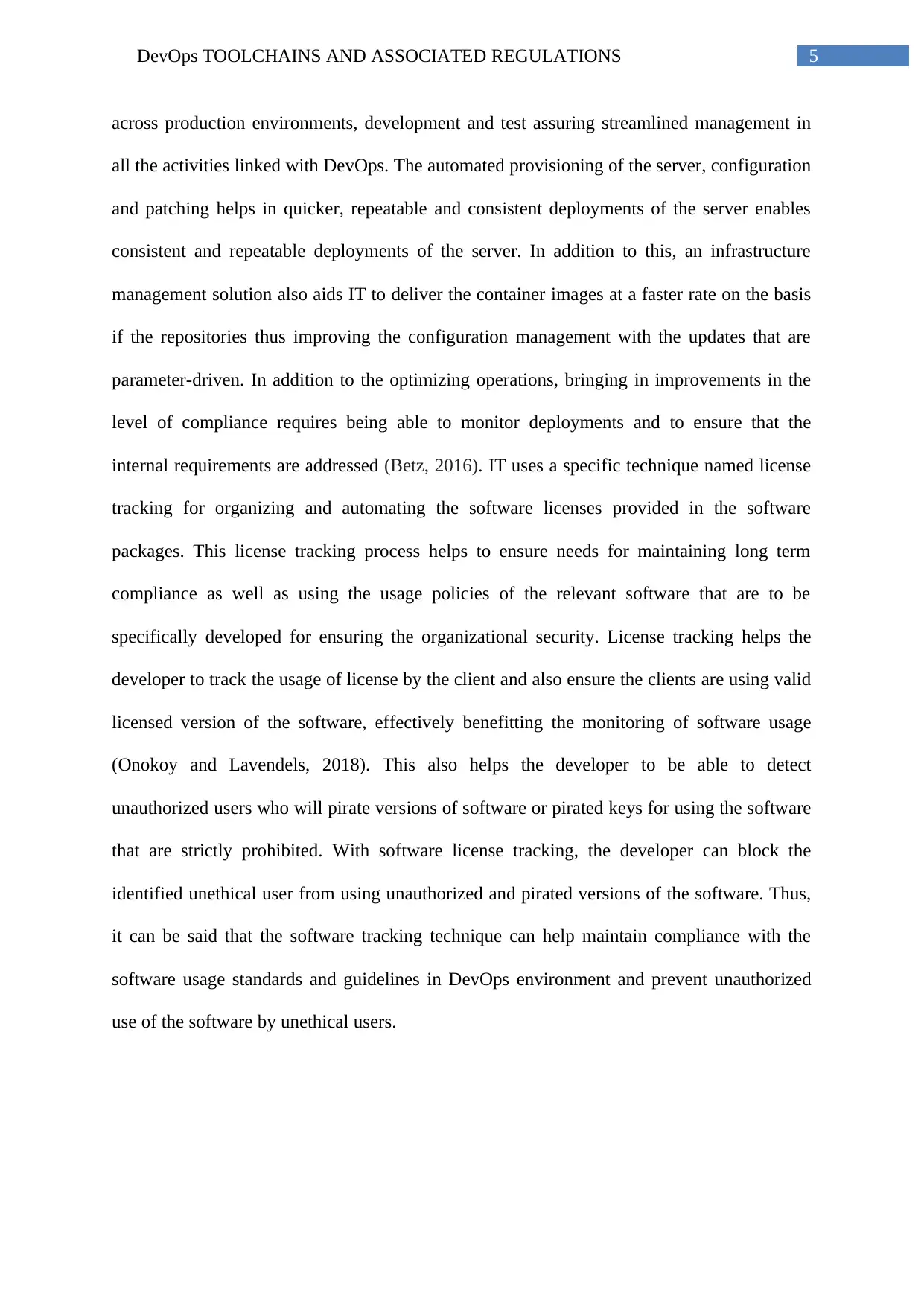
5DevOps TOOLCHAINS AND ASSOCIATED REGULATIONS
across production environments, development and test assuring streamlined management in
all the activities linked with DevOps. The automated provisioning of the server, configuration
and patching helps in quicker, repeatable and consistent deployments of the server enables
consistent and repeatable deployments of the server. In addition to this, an infrastructure
management solution also aids IT to deliver the container images at a faster rate on the basis
if the repositories thus improving the configuration management with the updates that are
parameter-driven. In addition to the optimizing operations, bringing in improvements in the
level of compliance requires being able to monitor deployments and to ensure that the
internal requirements are addressed (Betz, 2016). IT uses a specific technique named license
tracking for organizing and automating the software licenses provided in the software
packages. This license tracking process helps to ensure needs for maintaining long term
compliance as well as using the usage policies of the relevant software that are to be
specifically developed for ensuring the organizational security. License tracking helps the
developer to track the usage of license by the client and also ensure the clients are using valid
licensed version of the software, effectively benefitting the monitoring of software usage
(Onokoy and Lavendels, 2018). This also helps the developer to be able to detect
unauthorized users who will pirate versions of software or pirated keys for using the software
that are strictly prohibited. With software license tracking, the developer can block the
identified unethical user from using unauthorized and pirated versions of the software. Thus,
it can be said that the software tracking technique can help maintain compliance with the
software usage standards and guidelines in DevOps environment and prevent unauthorized
use of the software by unethical users.
across production environments, development and test assuring streamlined management in
all the activities linked with DevOps. The automated provisioning of the server, configuration
and patching helps in quicker, repeatable and consistent deployments of the server enables
consistent and repeatable deployments of the server. In addition to this, an infrastructure
management solution also aids IT to deliver the container images at a faster rate on the basis
if the repositories thus improving the configuration management with the updates that are
parameter-driven. In addition to the optimizing operations, bringing in improvements in the
level of compliance requires being able to monitor deployments and to ensure that the
internal requirements are addressed (Betz, 2016). IT uses a specific technique named license
tracking for organizing and automating the software licenses provided in the software
packages. This license tracking process helps to ensure needs for maintaining long term
compliance as well as using the usage policies of the relevant software that are to be
specifically developed for ensuring the organizational security. License tracking helps the
developer to track the usage of license by the client and also ensure the clients are using valid
licensed version of the software, effectively benefitting the monitoring of software usage
(Onokoy and Lavendels, 2018). This also helps the developer to be able to detect
unauthorized users who will pirate versions of software or pirated keys for using the software
that are strictly prohibited. With software license tracking, the developer can block the
identified unethical user from using unauthorized and pirated versions of the software. Thus,
it can be said that the software tracking technique can help maintain compliance with the
software usage standards and guidelines in DevOps environment and prevent unauthorized
use of the software by unethical users.
⊘ This is a preview!⊘
Do you want full access?
Subscribe today to unlock all pages.

Trusted by 1+ million students worldwide
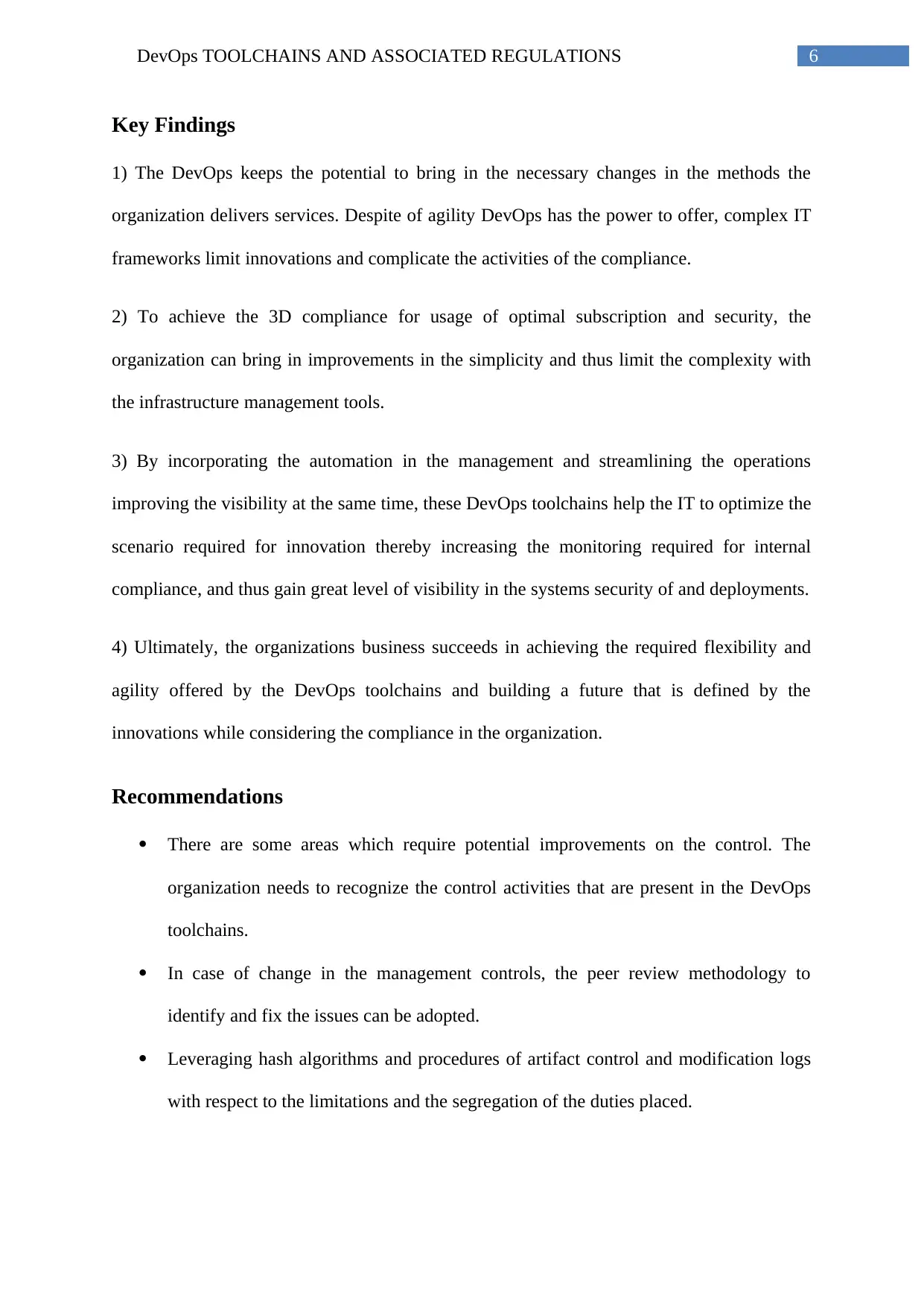
6DevOps TOOLCHAINS AND ASSOCIATED REGULATIONS
Key Findings
1) The DevOps keeps the potential to bring in the necessary changes in the methods the
organization delivers services. Despite of agility DevOps has the power to offer, complex IT
frameworks limit innovations and complicate the activities of the compliance.
2) To achieve the 3D compliance for usage of optimal subscription and security, the
organization can bring in improvements in the simplicity and thus limit the complexity with
the infrastructure management tools.
3) By incorporating the automation in the management and streamlining the operations
improving the visibility at the same time, these DevOps toolchains help the IT to optimize the
scenario required for innovation thereby increasing the monitoring required for internal
compliance, and thus gain great level of visibility in the systems security of and deployments.
4) Ultimately, the organizations business succeeds in achieving the required flexibility and
agility offered by the DevOps toolchains and building a future that is defined by the
innovations while considering the compliance in the organization.
Recommendations
There are some areas which require potential improvements on the control. The
organization needs to recognize the control activities that are present in the DevOps
toolchains.
In case of change in the management controls, the peer review methodology to
identify and fix the issues can be adopted.
Leveraging hash algorithms and procedures of artifact control and modification logs
with respect to the limitations and the segregation of the duties placed.
Key Findings
1) The DevOps keeps the potential to bring in the necessary changes in the methods the
organization delivers services. Despite of agility DevOps has the power to offer, complex IT
frameworks limit innovations and complicate the activities of the compliance.
2) To achieve the 3D compliance for usage of optimal subscription and security, the
organization can bring in improvements in the simplicity and thus limit the complexity with
the infrastructure management tools.
3) By incorporating the automation in the management and streamlining the operations
improving the visibility at the same time, these DevOps toolchains help the IT to optimize the
scenario required for innovation thereby increasing the monitoring required for internal
compliance, and thus gain great level of visibility in the systems security of and deployments.
4) Ultimately, the organizations business succeeds in achieving the required flexibility and
agility offered by the DevOps toolchains and building a future that is defined by the
innovations while considering the compliance in the organization.
Recommendations
There are some areas which require potential improvements on the control. The
organization needs to recognize the control activities that are present in the DevOps
toolchains.
In case of change in the management controls, the peer review methodology to
identify and fix the issues can be adopted.
Leveraging hash algorithms and procedures of artifact control and modification logs
with respect to the limitations and the segregation of the duties placed.
Paraphrase This Document
Need a fresh take? Get an instant paraphrase of this document with our AI Paraphraser
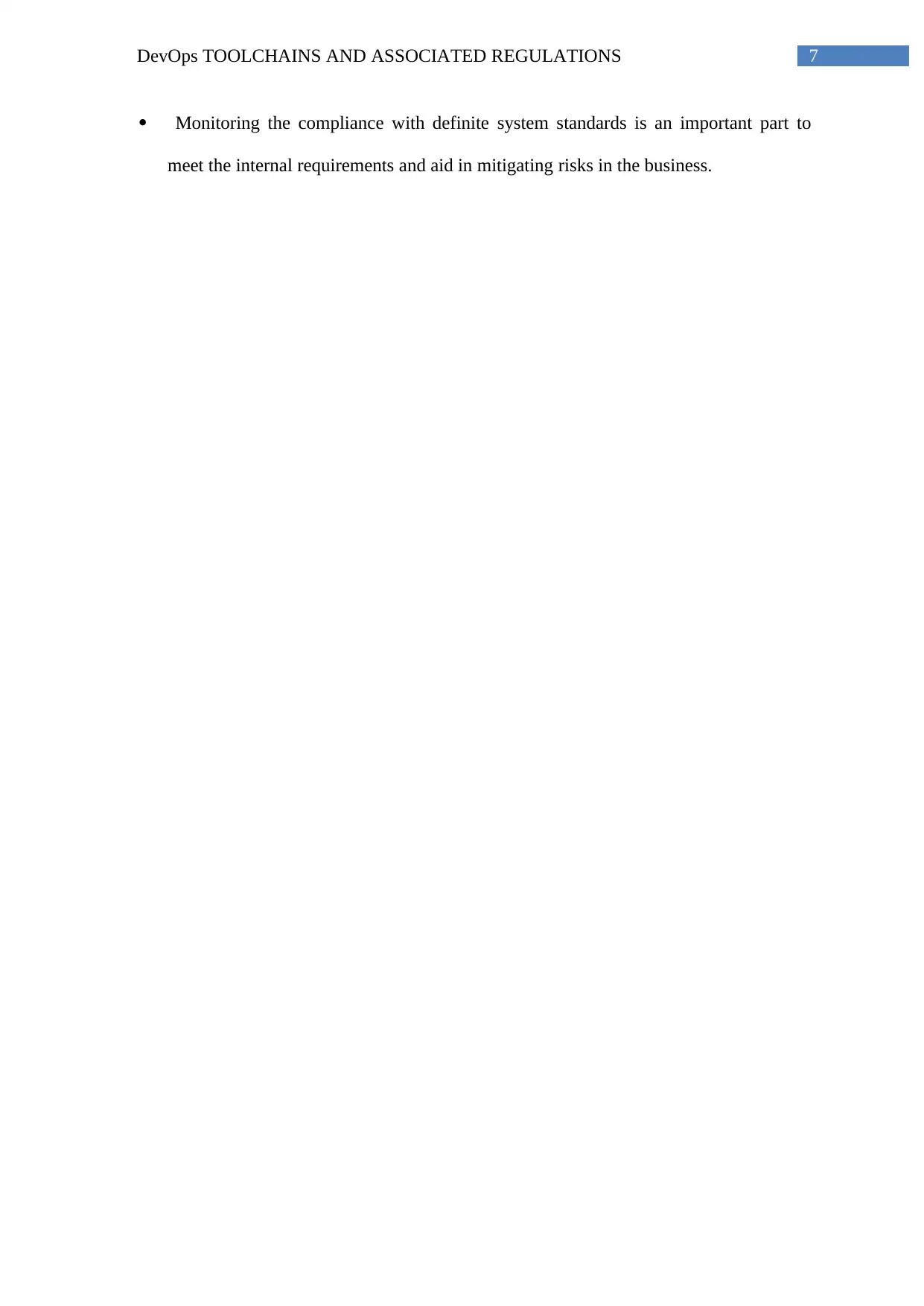
7DevOps TOOLCHAINS AND ASSOCIATED REGULATIONS
Monitoring the compliance with definite system standards is an important part to
meet the internal requirements and aid in mitigating risks in the business.
Monitoring the compliance with definite system standards is an important part to
meet the internal requirements and aid in mitigating risks in the business.
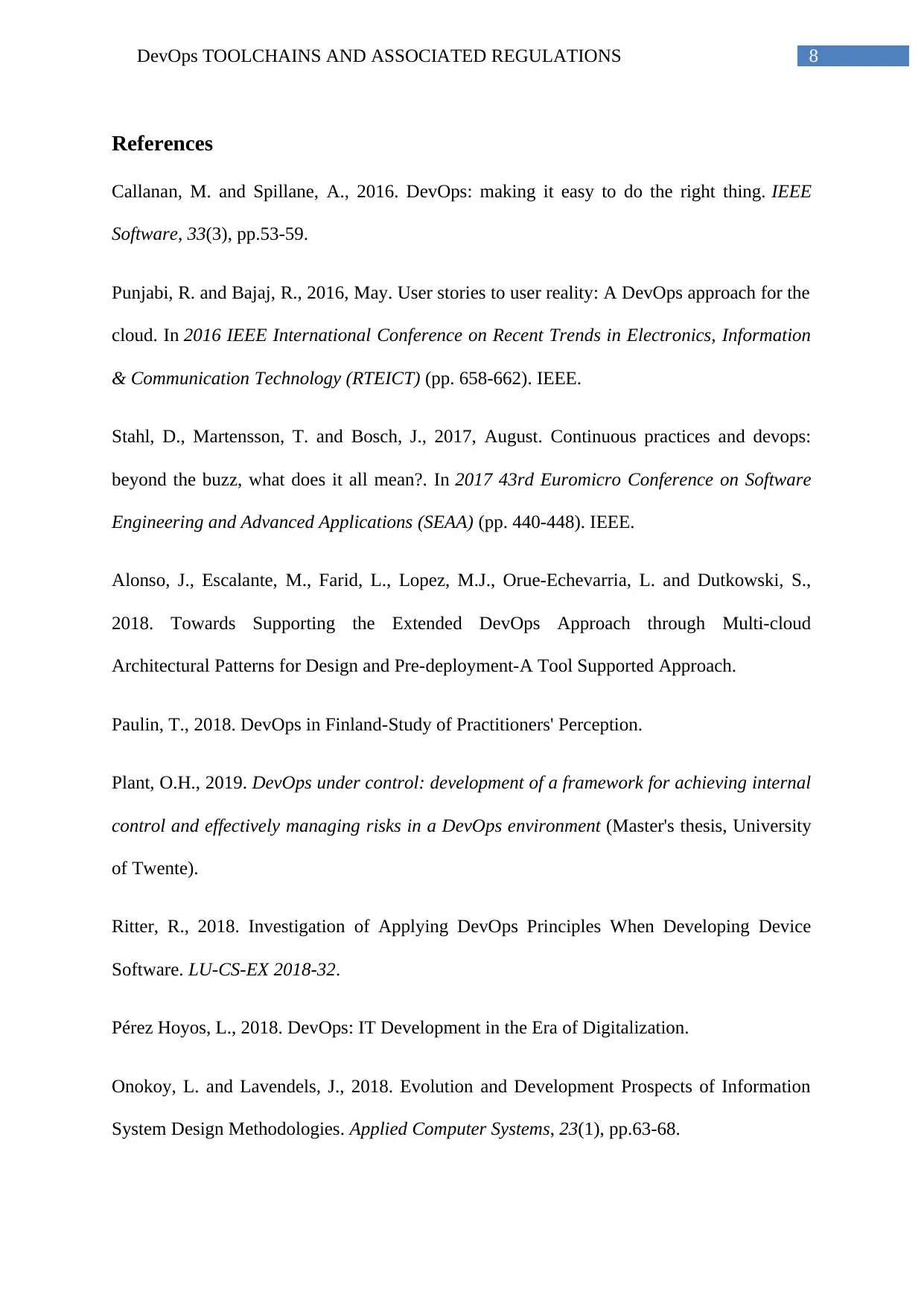
8DevOps TOOLCHAINS AND ASSOCIATED REGULATIONS
References
Callanan, M. and Spillane, A., 2016. DevOps: making it easy to do the right thing. IEEE
Software, 33(3), pp.53-59.
Punjabi, R. and Bajaj, R., 2016, May. User stories to user reality: A DevOps approach for the
cloud. In 2016 IEEE International Conference on Recent Trends in Electronics, Information
& Communication Technology (RTEICT) (pp. 658-662). IEEE.
Stahl, D., Martensson, T. and Bosch, J., 2017, August. Continuous practices and devops:
beyond the buzz, what does it all mean?. In 2017 43rd Euromicro Conference on Software
Engineering and Advanced Applications (SEAA) (pp. 440-448). IEEE.
Alonso, J., Escalante, M., Farid, L., Lopez, M.J., Orue-Echevarria, L. and Dutkowski, S.,
2018. Towards Supporting the Extended DevOps Approach through Multi-cloud
Architectural Patterns for Design and Pre-deployment-A Tool Supported Approach.
Paulin, T., 2018. DevOps in Finland-Study of Practitioners' Perception.
Plant, O.H., 2019. DevOps under control: development of a framework for achieving internal
control and effectively managing risks in a DevOps environment (Master's thesis, University
of Twente).
Ritter, R., 2018. Investigation of Applying DevOps Principles When Developing Device
Software. LU-CS-EX 2018-32.
Pérez Hoyos, L., 2018. DevOps: IT Development in the Era of Digitalization.
Onokoy, L. and Lavendels, J., 2018. Evolution and Development Prospects of Information
System Design Methodologies. Applied Computer Systems, 23(1), pp.63-68.
References
Callanan, M. and Spillane, A., 2016. DevOps: making it easy to do the right thing. IEEE
Software, 33(3), pp.53-59.
Punjabi, R. and Bajaj, R., 2016, May. User stories to user reality: A DevOps approach for the
cloud. In 2016 IEEE International Conference on Recent Trends in Electronics, Information
& Communication Technology (RTEICT) (pp. 658-662). IEEE.
Stahl, D., Martensson, T. and Bosch, J., 2017, August. Continuous practices and devops:
beyond the buzz, what does it all mean?. In 2017 43rd Euromicro Conference on Software
Engineering and Advanced Applications (SEAA) (pp. 440-448). IEEE.
Alonso, J., Escalante, M., Farid, L., Lopez, M.J., Orue-Echevarria, L. and Dutkowski, S.,
2018. Towards Supporting the Extended DevOps Approach through Multi-cloud
Architectural Patterns for Design and Pre-deployment-A Tool Supported Approach.
Paulin, T., 2018. DevOps in Finland-Study of Practitioners' Perception.
Plant, O.H., 2019. DevOps under control: development of a framework for achieving internal
control and effectively managing risks in a DevOps environment (Master's thesis, University
of Twente).
Ritter, R., 2018. Investigation of Applying DevOps Principles When Developing Device
Software. LU-CS-EX 2018-32.
Pérez Hoyos, L., 2018. DevOps: IT Development in the Era of Digitalization.
Onokoy, L. and Lavendels, J., 2018. Evolution and Development Prospects of Information
System Design Methodologies. Applied Computer Systems, 23(1), pp.63-68.
⊘ This is a preview!⊘
Do you want full access?
Subscribe today to unlock all pages.

Trusted by 1+ million students worldwide
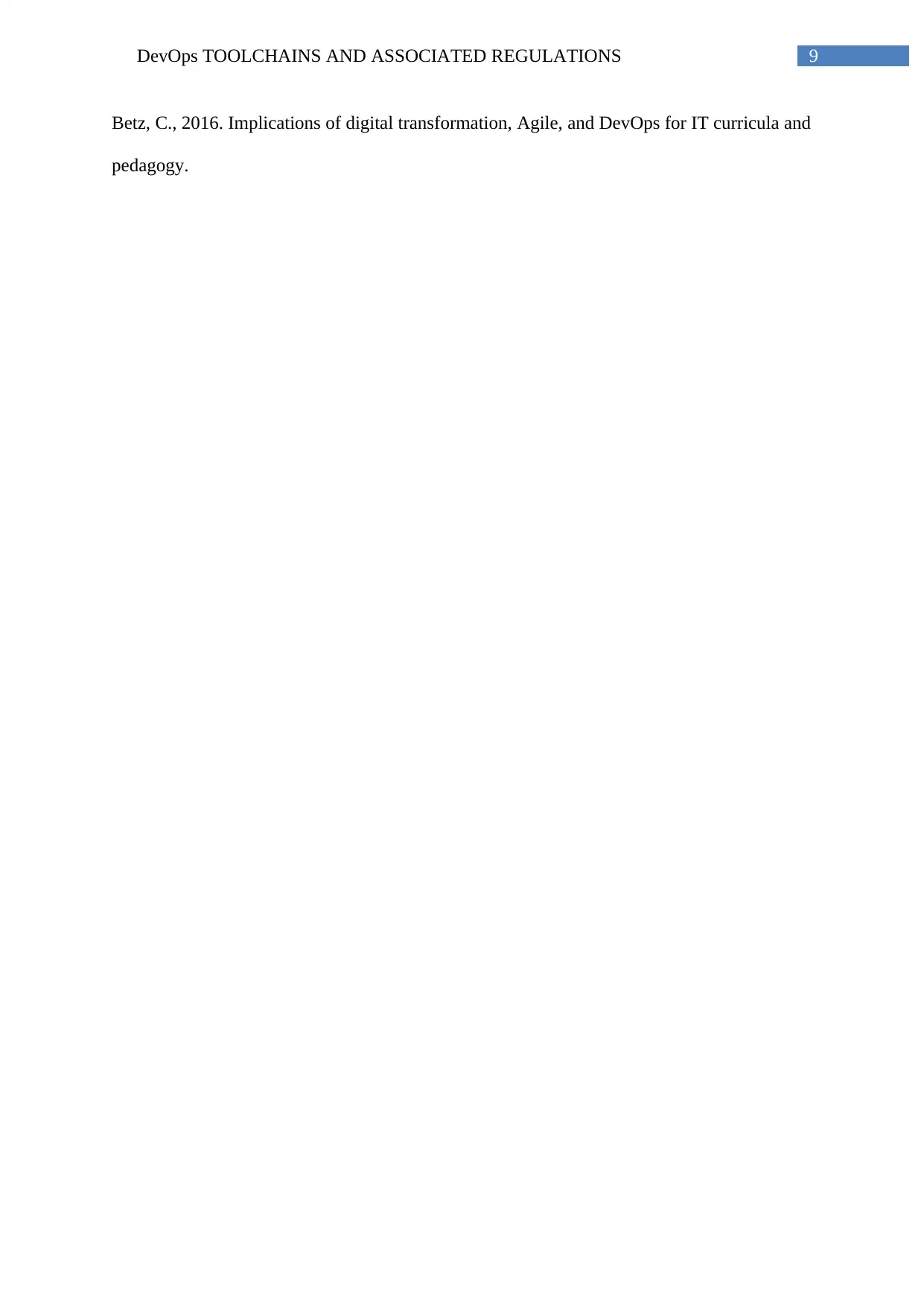
9DevOps TOOLCHAINS AND ASSOCIATED REGULATIONS
Betz, C., 2016. Implications of digital transformation, Agile, and DevOps for IT curricula and
pedagogy.
Betz, C., 2016. Implications of digital transformation, Agile, and DevOps for IT curricula and
pedagogy.
1 out of 10
Your All-in-One AI-Powered Toolkit for Academic Success.
+13062052269
info@desklib.com
Available 24*7 on WhatsApp / Email
![[object Object]](/_next/static/media/star-bottom.7253800d.svg)
Unlock your academic potential
Copyright © 2020–2025 A2Z Services. All Rights Reserved. Developed and managed by ZUCOL.
